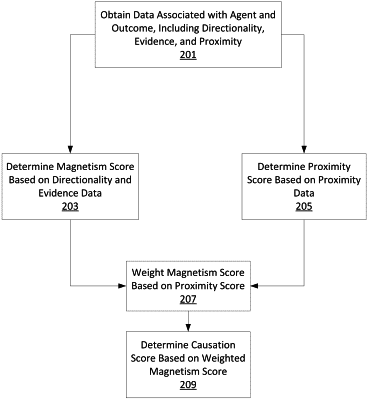| CPC G06N 5/041 (2013.01) [G06F 16/93 (2019.01); G06F 17/11 (2013.01); G06N 5/04 (2013.01); G06N 7/01 (2023.01)] | 20 Claims |

|
1. A computer-implemented method of displaying, on a display device, a general causation visualization for an agent and an outcome, the method comprising:
processing a corpus of scientific article metadata to obtain two subsets associated with the agent and the outcome, including a first dataset associated with a first year, and a second dataset associated with a second year;
displaying the general causation visualization on the display device;
displaying, in a portion of the general causation visualization associated with the first year, a representation of a first causation score computed by:
determining a respective magnetism score for each respective article in the first dataset based on directionality data, the directionality data indicating whether the respective article supports or rejects a hypothesis that the agent causes the outcome, and evidence data, the evidence data indicating how well methodology of the article can demonstrate a causal relationship between the agent and the outcome,
aggregating the respective magnetism scores for the articles in the first dataset to obtain a magnetism score for the first dataset,
weighting the magnetism score based on proximity data indicating directness of evidence in each article in the first dataset, and
computing the first causation score based on the weighted magnetism score; and
displaying, in a portion of the general causation visualization associated with the second year, a representation of a second causation score computed based on the second dataset associated with the second year, including:
determining a random walk from a short term average publication rate,
computing a future publication count based on the random walk, and
computing the second causation score based on the future publication count.
|